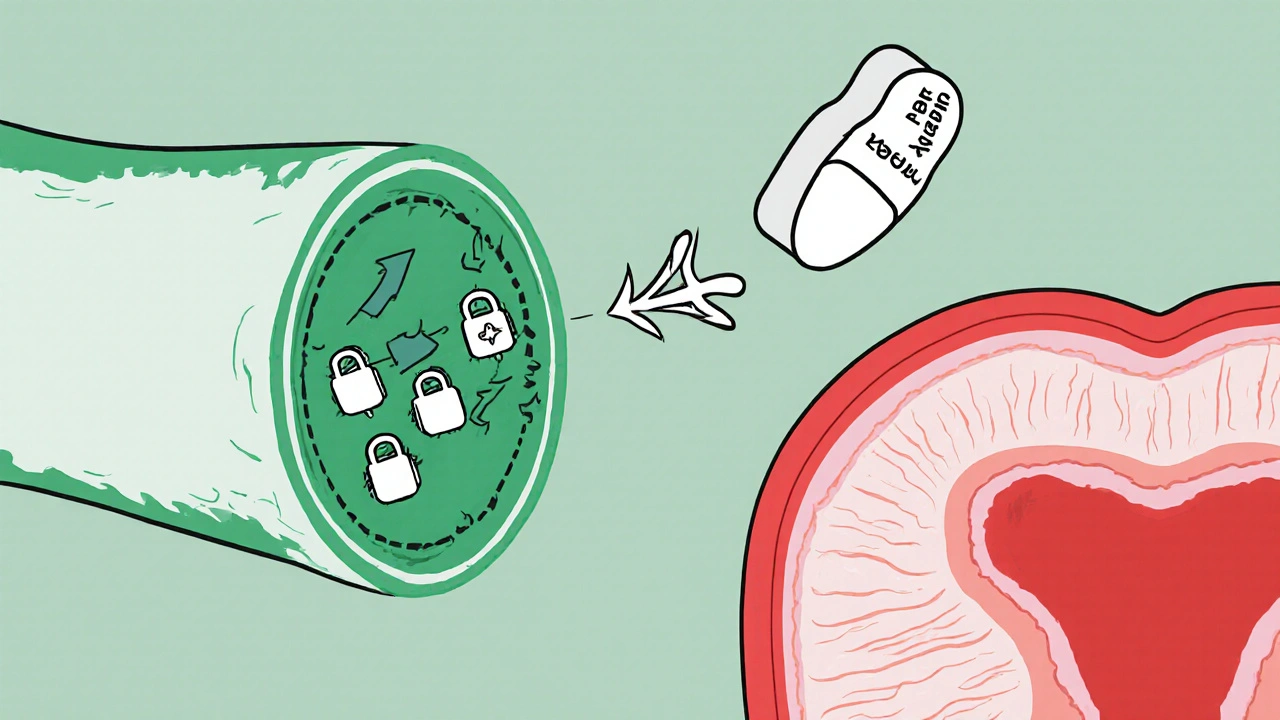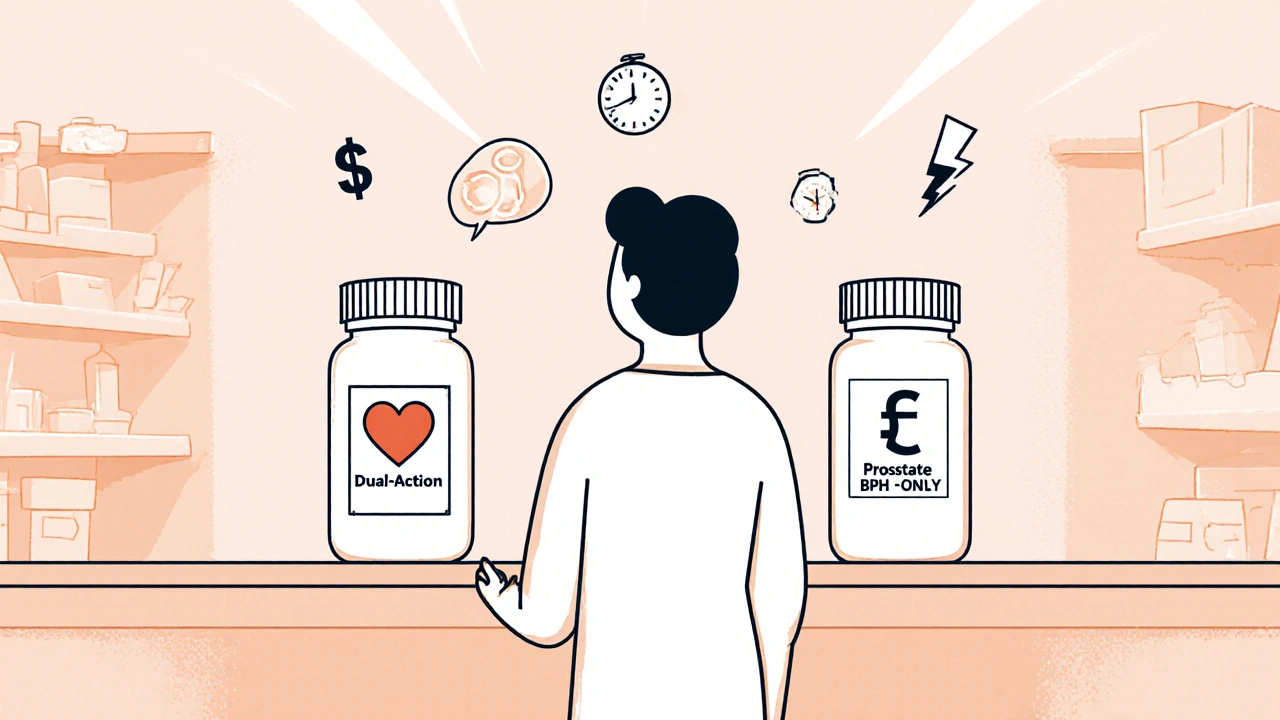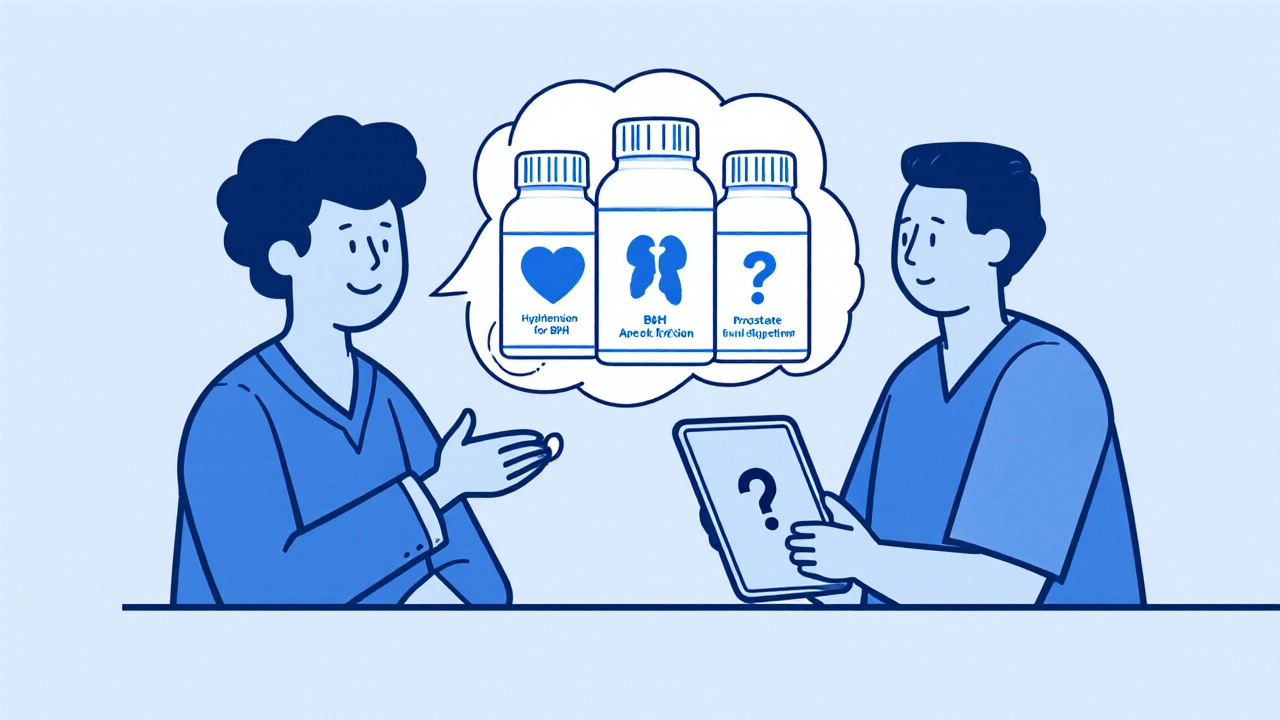When your doctor prescribes an alpha‑1 blocker, the choice isn’t always clear. compare doxazosin with its peers and you’ll see which drug fits your blood‑pressure or prostate‑symptom goals, how the side‑effect profiles differ, and what practical factors (cost, dosing, interactions) should drive the decision.
Quick Takeaways
- Doxazosin works for both hypertension and benign prostatic hyperplasia (BPH) with a once‑daily dose.
- Terazosin has a similar dual use but a slightly shorter half‑life, often requiring a morning dose.
- Prazosin is mainly used for hypertension and nightmares in PTSD; it’s less effective for BPH.
- Tamsulosin and alfuzosin focus on BPH only, offering fewer cardiovascular effects.
- Choose based on primary indication, tolerability, and how the drug fits your daily routine.
What Is Doxazosin?
Doxazosin is a selective alpha‑1 adrenergic receptor blocker approved for treating hypertension and BPH. It was first launched in the United States in 1995 and quickly became popular because a single daily dose can control both blood‑pressure spikes and urinary flow problems.
How Alpha‑1 Blockers Work
All the drugs we’ll discuss belong to the alpha‑1 blocker family. They relax smooth muscle by preventing norepinephrine from binding to alpha‑1 receptors on blood vessels and the prostate’s stromal tissue. The result is lowered vascular resistance (dropping blood pressure) and reduced prostate‑neck constriction (improving urine flow).
Key Alternatives
Below are the most common peers you’ll hear about when weighing options against doxazosin.
Terazosin is another dual‑indication alpha‑1 blocker, introduced a few years before doxazosin. Its dosing usually starts at 1 mg at bedtime, with a typical maintenance range of 2-10 mg.
Prazosin is primarily an antihypertensive that also treats PTSD‑related nightmares. Its short half‑life (2-3 hours) means multiple daily doses are common, and it’s not the first choice for BPH.
Tamsulosin focuses on BPH without major blood‑pressure effects. Its high selectivity for alpha‑1A receptors in the prostate gives fewer cardiovascular side effects but means it won’t help hypertension.
Alfuzosin is similar to tamsulosin-BPH‑specific, once‑daily, and generally well‑tolerated. Its neutral effect on blood pressure makes it a safe backup when heart issues are a concern.

Dosage & Administration
Understanding how each drug is taken helps you predict adherence challenges.
- Doxazosin: Start 1 mg daily, usually at bedtime to avoid first‑dose orthostatic hypotension. Typical maintenance 2-8 mg once a day.
- Terazosin: Begin 1 mg at night; increase by 1 mg weekly. Maintenance 2-10 mg daily, often split between morning and night for some patients.
- Prazosin: Initiate 1 mg at bedtime for hypertension; may add a second dose in the morning. PTSD dosing can be 1 mg at night, titrated up to 15 mg total daily.
- Tamsulosin: Fixed 0.4 mg capsule taken 30 minutes after the same meal each day.
- Alfuzosin: 10 mg extended‑release tablet taken after the same meal daily.
Side‑Effect Profile
All alpha‑1 blockers share some common adverse events, but the frequency and severity differ.
| Drug | Dizziness/Light‑Headedness | Fatigue | Retrograde Ejaculation | Nasopharyngeal Symptoms |
|---|---|---|---|---|
| Doxazosin | 10‑15% | 5‑10% | 2‑4% | 3‑5% |
| Terazosin | 12‑18% | 6‑12% | 3‑5% | 4‑6% |
| Prazosin | 8‑12% | 4‑8% | 1‑2% | 2‑4% |
| Tamsulosin | 5‑8% | 3‑6% | 15‑25% | 1‑3% |
| Alfuzosin | 6‑9% | 4‑7% | 12‑18% | 2‑4% |
Notice the higher rates of retrograde ejaculation with the prostate‑specific agents (tamsulosin, alfuzosin). If sexual side effects matter, doxazosin or terazosin may be preferable.
Drug Interactions & Contra‑Indications
Because these drugs lower blood pressure, combine them cautiously with:
- Other antihypertensives (ACE inhibitors, diuretics, beta‑blockers).
- Phosphodiesterase‑5 inhibitors (e.g., sildenafil) - the combo can cause marked hypotension.
- Potassium‑sparing diuretics - raise risk of hyperkalemia when paired with ACE inhibitors.
All agents are contraindicated in patients with severe hepatic impairment (especially doxazosin and terazosin) because metabolism is liver‑dependent.

Cost & Availability (2025)
Generic versions dominate the market. Approximate US average wholesale prices per month:
- Doxazosin - $10‑$12
- Terazosin - $9‑$11
- Prazosin - $8‑$10
- Tamsulosin - $15‑$20 (brand‑only for some formulations)
- Alfuzosin - $12‑$16
In the UK, the NHS list price for the 4 mg tablet of doxazosin is £0.07, making it one of the most affordable dual‑indication options.
How to Choose the Right Alpha‑1 Blocker
- Identify the primary problem. If high blood pressure is the main issue, doxazosin or terazosin give you a two‑in‑one solution. For isolated BPH without hypertension, tamsulosin or alfuzosin avoid unnecessary cardiovascular effects.
- Assess tolerance. Patients prone to dizziness benefit from the slower‑acting, longer‑half‑life profile of doxazosin (half‑life ~22 hours) compared with prazosin’s short burst.
- Consider dosing convenience. A once‑daily pill at night (doxazosin, tamsulosin, alfuzosin) improves adherence over multi‑dose regimens like prazosin.
- Check for sexual side‑effects. If retrograde ejaculation is a deal‑breaker, avoid tamsulosin and alfuzosin; opt for doxazosin or terazosin.
- Review drug‑interaction risks. Patients on PDE‑5 inhibitors should discuss timing adjustments or alternative therapies.
In practice, many clinicians start with doxazosin for a patient who has both hypertension and mild BPH, then switch to a prostate‑specific agent if sexual side‑effects become problematic.
FAQ
Can I take doxazosin if I only have high blood pressure?
Absolutely. Doxazosin was originally approved for hypertension, and many patients use it without any prostate issues. The dose may be lower (1‑4 mg) compared to the BPH range.
Why do I feel dizzy after my first dose?
Alpha‑1 blockers cause a sudden drop in blood pressure when you stand up, known as orthostatic hypotension. Taking the first dose at bedtime and starting with 1 mg helps the body adjust.
Is doxazosin safe for people over 80?
Older adults often have a higher risk of falls from dizziness. A very low starting dose (0.5 mg if available, otherwise 1 mg) and careful monitoring are recommended.
How does doxazosin compare to tamsulosin for BPH relief?
Both improve urine flow, but tamsulosin is more prostate‑selective, so you’re less likely to feel a blood‑pressure drop. However, tamsulosin has a higher chance of causing retrograde ejaculation.
Can I combine doxazosin with a PDE‑5 inhibitor like Cialis?
You can, but only under a doctor’s supervision. The combo may lead to a sudden drop in blood pressure, so dosage timing and monitoring are essential.
By mapping your clinical picture to the strengths and downsides of each agent, you’ll land on a medication that controls your numbers without a surprise side‑effect. Whether you stick with doxazosin’s dual action or switch to a BPH‑focused blocker, the choice becomes clearer once you compare the key attributes.

All Comments
kenny lastimosa October 23, 2025
Doxazosin sits at an interesting crossroads between cardiology and urology, prompting us to reflect on the nature of poly‑functional drugs.
The when a molecule can lower systemic vascular resistance while simultaneously relaxing the prostate sphincter, it challenges the reductionist view of medication categories.
The pharmacokinetic profile, with a half‑life nearing 22 hours, invites patients to embrace a once‑daily rhythm that mirrors natural circadian patterns.
Yet the same prolonged action can cast a shadow of orthostatic hypotension, especially after that first nighttime dose.
Philosophically, this tension mirrors the human condition: the desire for convenience entangled with the risk of unintended side effects.
Clinicians must weigh the dual benefit against the modest increase in dizziness that appears in roughly one‑in‑ten patients.
Compare this with terazosin, whose slightly shorter half‑life often mandates a split dosing schedule, nudging patients toward greater regimen complexity.
Prazosin, by contrast, offers a fleeting window of blood pressure control, demanding multiple daily administrations that can erode adherence.
The prostate‑selective agents tamsulosin and alfuzosin excel in minimizing cardiovascular impact, yet they introduce a markedly higher incidence of retrograde ejaculation.
For a patient whose primary concern is hypertension with a hint of BPH, doxazosin’s balanced profile may feel like a philosophical middle path.
Economically, the generic availability keeps the monthly cost well within the reach of most insurance formularies, reinforcing its pragmatic appeal.
However, cost should never eclipse safety; liver impairment remains a contraindication that cannot be ignored.
From a mechanistic standpoint, doxazosin’s selectivity for alpha‑1 receptors ensures a predictable vasodilatory response, unlike the occasional surprise of non‑selective agents.
In practice, many prescribers start low, perhaps 0.5 mg if attainable, and titrate upward to monitor tolerance.
The patient’s lifestyle-whether they can tolerate a bedtime dose or need morning dosing-adds another layer to the decision matrix.
Ultimately, the choice between doxazosin and its peers reflects a broader ethical dialogue about individualizing therapy in the age of evidence‑based medicine.
keerthi yeligay October 23, 2025
If you’re looking for a drug that covers both blood pressure and BPH, doxazosin is a solid bet. Just remember to start low and watch out for that dizzy feeling, it’s reely common at first.
sara fanisha October 23, 2025
Nice rundown, seems like doxazosin could simplify a lot of med lists. Hope you find the right fit, stay positive!
Tristram Torres October 24, 2025
Doxazosin is just a cheap all‑rounder, nothing special.
Jinny Shin October 24, 2025
Ah, the reductive whisper of the masses! One must appreciate the nuanced ballet of receptor affinity that doxazosin performs beneath the clinical surface. To dismiss it as merely cheap is to ignore the symphonic harmony of dual‑action therapy.
deepak tanwar October 24, 2025
While the low‑dose initiation is advisable, one must also acknowledge that dose titration can be rendered moot in patients with robust renal clearance, where higher initial doses achieve therapeutic targets more expediently. Nevertheless, the author's caution remains a respectable clinical heuristic.
Abhishek Kumar October 24, 2025
Meh, looks fine.
hema khatri October 24, 2025
Great article!!! Doxazosin truly shines as a versatile option!!! Especially for those who love simplicity!!!
Jennell Vandermolen October 24, 2025
I appreciate the thorough comparison; it really helps in shared decision‑making. For patients hesitant about dizziness, emphasizing the bedtime dosing strategy can be reassuring.
Mike Peuerböck October 24, 2025
Esteemed colleagues, the pharmacodynamic tapestry woven by doxazosin merits commendation. Its ability to orchestrate vasodilation whilst liberating urinary flow exemplifies therapeutic elegance. Moreover, the economic accessibility further amplifies its appeal across diverse patient populations.
Simon Waters October 24, 2025
Sure, but did you know the big pharma giants push tamsulosin to keep us dependent? Keep an eye on the agenda.
Vikas Kumar October 25, 2025
Our own healthcare system should prioritize home‑grown meds like doxazosin instead of importing fancy foreign brands that jack up prices. It’s a matter of national pride and self‑reliance.
Celeste Flynn October 25, 2025
From a practical standpoint, doxazosin’s once‑daily dosing aligns well with adherence data, reducing missed doses by roughly 20 %. Additionally, its side‑effect profile is modest, making it a suitable first‑line option for patients with combined hypertension and mild BPH.
Shan Reddy October 25, 2025
Yeah, the half‑life really smooths out blood pressure swings. Just watch the first‑dose tilt.
CASEY PERRY October 25, 2025
The therapeutic index of doxazosin remains favorable in polypharmacy contexts, warranting its inclusion in guideline‑driven algorithms. Clinicians should therefore consider it when optimizing dual‑indication regimens.